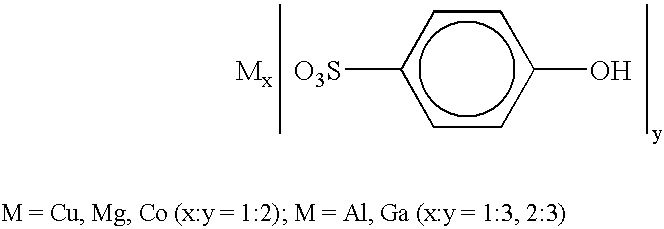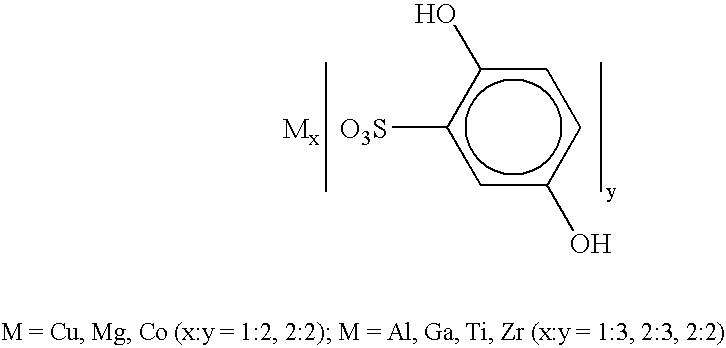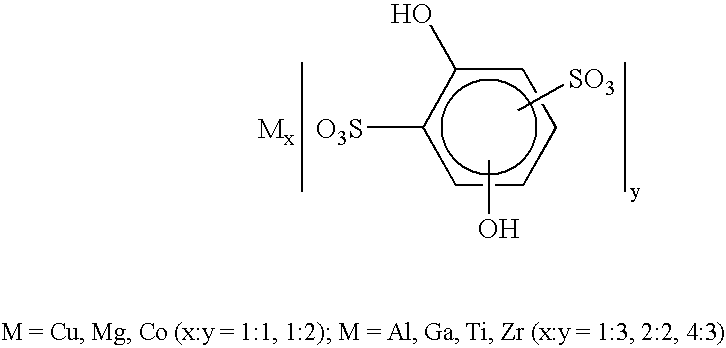Organometallic salts for inkjet receptor media
a technology of inkjet imaging and organic salts, which is applied in the field of organic salts for inkjet imaging media, can solve the problems of increased media and ink consumption, so as to achieve equal performance, minimize concentration, and maximize concentration
- Summary
- Abstract
- Description
- Claims
- Application Information
AI Technical Summary
Benefits of technology
Problems solved by technology
Method used
Image
Examples
example 1
Various classes of organometallic salts were prepared by refluxing appropriate quantities of metal chlorides and hydroxysulfonic acids in toluene for 8-9 hrs. The materials were filtered, dried in air and stored. In a typical experiment, to a solution of 90 g of 5-sulfosalicylic acid (0.35 mole) in 100 g toluene was added 15.7 g (0.12 mole) of aluminum chloride and the mixture was heated to near-reflux temperature of the solvent for about 8 hrs. The white solid precipitated was filtered and dried. The product was characterized by the usual analytical techniques. ##STR8##
example 2
The same classes of materials were also prepared by using appropriate metal alkoxides and hydroxysulfonic or sulfocarboxylic acids in water. Thus, aluminum isopropoxide was mixed with 5-sulfophthalic acid in 2:3 molar ratio and the mixture was heated to about 60.degree. C. for about 1 / 2 hr. Aluminum isopropoxide was hydrolyzed and the salt was obtained as aqueous solution and was used as such for inkjet coatings. Magnesium ethoxide was similarly hydrolyzed from its mixture with the same acid in 1:2 molar ratio to obtain magnesium sulfophthalate in aqueous solution. ##STR9##
example 3
The same class of salts were also prepared by yet another procedure Viz. metathetical ion-exchange. Thus, a solution of 5-sulfoisophthalic acid-Na salt (20 g, 0.075 mole) in methanol was mixed with magnesium chloride (3.5 g, 0.0375 mole), and the mixture was refluxed for about 1 / 2 hr. The solution was concentrated and sodium chloride was crystallized out. The solution was decanted to obtain 5-sulfoisophthalic acid-Mg salt in solution. ##STR10##
PUM
| Property | Measurement | Unit |
|---|---|---|
| Fraction | aaaaa | aaaaa |
| Fraction | aaaaa | aaaaa |
| Fraction | aaaaa | aaaaa |
Abstract
Description
Claims
Application Information
 Login to View More
Login to View More - R&D
- Intellectual Property
- Life Sciences
- Materials
- Tech Scout
- Unparalleled Data Quality
- Higher Quality Content
- 60% Fewer Hallucinations
Browse by: Latest US Patents, China's latest patents, Technical Efficacy Thesaurus, Application Domain, Technology Topic, Popular Technical Reports.
© 2025 PatSnap. All rights reserved.Legal|Privacy policy|Modern Slavery Act Transparency Statement|Sitemap|About US| Contact US: help@patsnap.com



